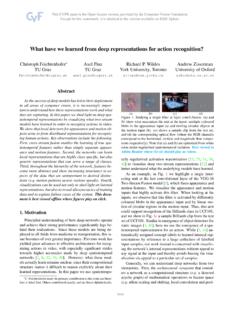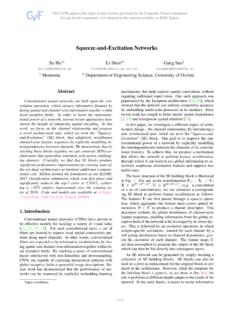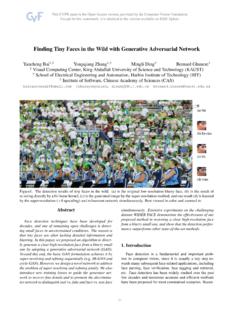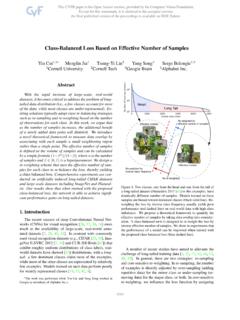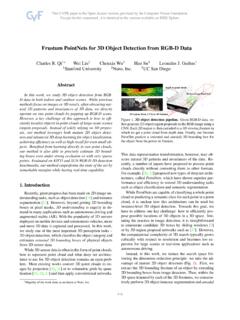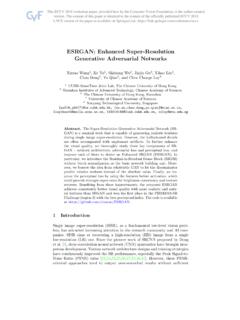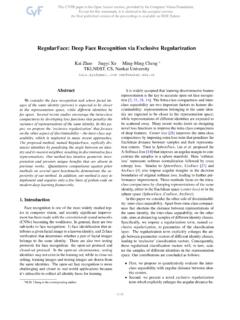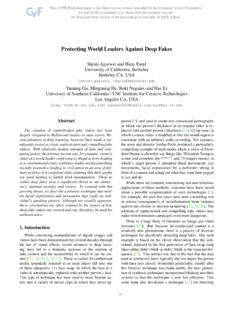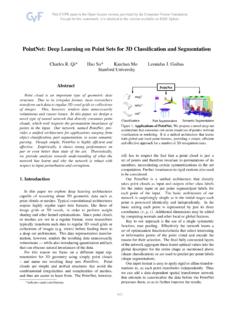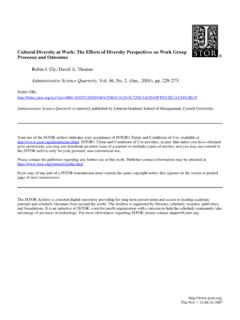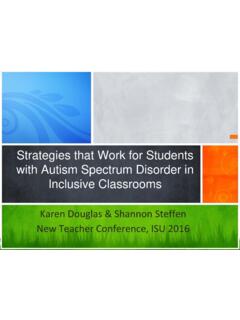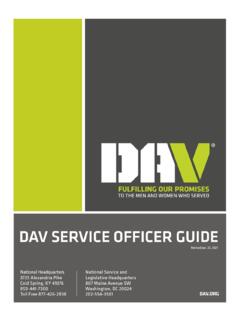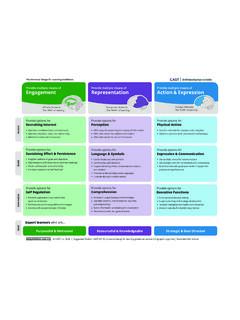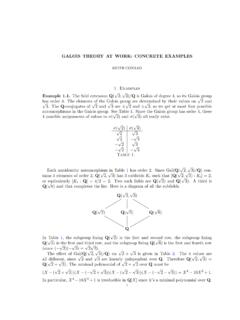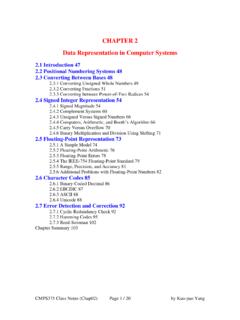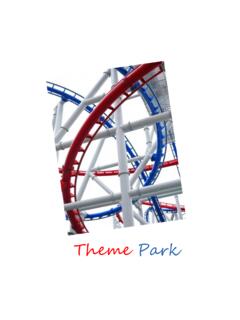Transcription of DeepSDF: Learning Continuous Signed Distance Functions for ...
1 DeepSDF: Learning Continuous Signed Distance Functionsfor Shape RepresentationJeong Joon Park1,3 Peter Florence2,3 Julian Straub3 Richard Newcombe3 Steven Lovegrove31 University of Washington2 Massachusetts Institute of Technology3 Facebook Reality LabsFigure 1:DeepSDF represents Signed Distance Functions (SDFs) of shapes via latent code-conditioned feed-forward decoder images are raycast renderings of DeepSDF interpolating between two shapes in the learned shape latent space. Best viewed graphics, 3D computer vision and roboticscommunities have produced multiple approaches to rep-resenting 3D geometry for rendering and provide trade-offs across fidelity, efficiency and com-pression capabilities.
2 In this work , we introduce DeepSDF,a learned Continuous Signed Distance Function (SDF) rep-resentation of a class of shapes that enables high qual-ity shape representation , interpolation and completion frompartial and noisy 3D input data. DeepSDF, like its clas-sical counterpart, represents a shape s surface by a con-tinuous volumetric field: the magnitude of a point in thefield represents the Distance to the surface boundary and thesign indicates whether the region is inside (-) or outside (+)of the shape, hence our representation implicitly encodes ashape s boundary as the zero-level-set of the learned func-tion while explicitly representing the classification of spaceas being part of the shapes interior or not.
3 While classicalSDF s both in analytical or discretized voxel form typicallyrepresent the surface of a single shape, DeepSDF can repre-sent an entire class of shapes. Furthermore, we show state-of-the-art performance for learned 3D shape representationand completion while reducing the model size by an orderof magnitude compared with previous performed while Park and Florence were interns at IntroductionDeep convolutional networks which are a mainstay ofimage-based approaches grow quickly in space and timecomplexity when directly generalized to the 3rd spatial di-mension, and more classical and compact surface repre-sentations such as triangle or quad meshes pose problemsin training since we may need to deal with an unknownnumber of vertices and arbitrary topology.
4 These chal-lenges have limited the quality, flexibility and fidelity ofdeep Learning approaches when attempting to either input3D data for processing or produce 3D inferences for objectsegmentation and this work , we present a novel representation and ap-proach for generative 3D modeling that is efficient, expres-sive, and fully Continuous . Our approach uses the conceptof a SDF, but unlike common surface reconstruction tech-niques which discretize this SDF into a regular grid for eval-uation and measurement denoising [14], we instead learn agenerative model to produce such a Continuous proposed Continuous representation may be intu-itively understood as a learned shape-conditioned classifierfor which the decision boundary is the surface of the shapeitself, as shown in Fig.
5 2. Our approach shares the genera-tive aspect of other works seeking to map a latent space toa distribution of complex shapes in 3D [52], but criticallydiffers in the central representation . While the notion of an1165 Decision boundaryof implicit surface(a)(b)(c)Figure 2:Our DeepSDF representation applied to the StanfordBunny: (a) depiction of the underlying implicit surfaceSDF= 0trained on sampled points insideSDF <0and outsideSDF >0the surface, (b) 2D cross-section of the Signed Distance field, (c)rendered 3D surface recovered fromSDF= 0. Note that (b) and(c) are recovered via surface defined as a SDF is widely known in thecomputer vision and graphics communities, to our knowl-edge no prior works have attempted to directly learn contin-uous, generalizable 3D generative models of contributions include: (i) the formulation of gen-erative shape-conditioned 3D modeling with a continuousimplicit surface, (ii) a Learning method for 3D shapes basedon a probabilistic auto-decoder, and (iii) the demonstrationand application of this formulation to shape modeling andcompletion.
6 Our models produce high quality continuoussurfaces with complex topologies, and obtain state-of-the-art results in quantitative comparisons for shape reconstruc-tion and completion. As an example of the effectivenessof our method, our models use only MB (megabytes)of memory to represent entire classes of shapes (for exam-ple, thousands of 3D chair models) this is, for example,less than half the memory footprint ( MB) of a singleuncompressed51233D Related WorkWe review three main areas of related work : 3D rep-resentations for shape Learning (Sec. ), techniques forlearning generative models (Sec. ), and shape comple-tion (Sec.)
7 Representations for 3D Shape LearningRepresentations for data-driven 3D Learning approachescan be largely classified into three categories: point-based,mesh-based, and voxel-based methods. While some appli-cations such as 3D-point-cloud-based object classificationare well suited to these representations, we address theirlimitations in expressing Continuous surfaces with point cloud is a lightweight 3D representa-tion that closely matches the raw data that many sensors ( , depth cameras) provide, and hence is a natural fitfor applying 3D Learning . PointNet [36], for example, usesmax-pool operations to extract global shape features, andthe technique is widely used as an encoder for point genera-tion networks [55, 1].
8 There is a sizable list of related worksfor Learning on point clouds [37, 51, 56]. A primary limi-tation, however, of Learning with point clouds is that theydo not describe topology and are not suitable for producingwatertight approaches represent classes of sim-ilarly shaped objects, such as morphable human body parts,with predefined template meshes and some of these modelsdemonstrate high fidelity shape generation results [2, 31].Other recent works [3] use poly-cube mapping [48] forshape optimization. While the use of template meshes isconvenient and naturally provides 3D correspondences, itcan only model shapes with fixed mesh mesh-based methods use existing [45, 33] orlearned [19, 20] parameterization techniques to describe 3 Dsurfaces by morphing 2D planes.
9 The quality of such repre-sentations depends on parameterization algorithms that areoften sensitive to input mesh quality and cutting address this, recent data-driven approaches [55, 19] learnthe parameterization task with deep networks. They report,however, that (a) multiple planes are required to describecomplex topologies but (b) the generated surface patchesare not stitched, the produced shape is not closed. Togenerate a closed mesh, sphere parameterization may beused [19, 20], but the resulting shape is limited to the topo-logical sphere. Other works related to Learning on meshespropose to use new convolution and pooling operations formeshes [16, 50] or general graphs [8].
10 , which non-parametrically describevolumes with 3D grids of values, are perhaps the most natu-ral extension into the 3D domain of the well-known learningparadigms ( , convolution) that have excelled in the 2 Dimage domain. The most straightforward variant of voxel-based Learning is to use a dense occupancy grid (occupied /not occupied). Due to the cubically growing compute andmemory requirements, however, current methods are onlyable to handle low resolutions (1283or below). As such,voxel-based approaches do not preserve fine shape details[54, 13], and additionally voxels visually appear signifi-cantly different than high-fidelity shapes, since when ren-dered their normals are not smooth.
